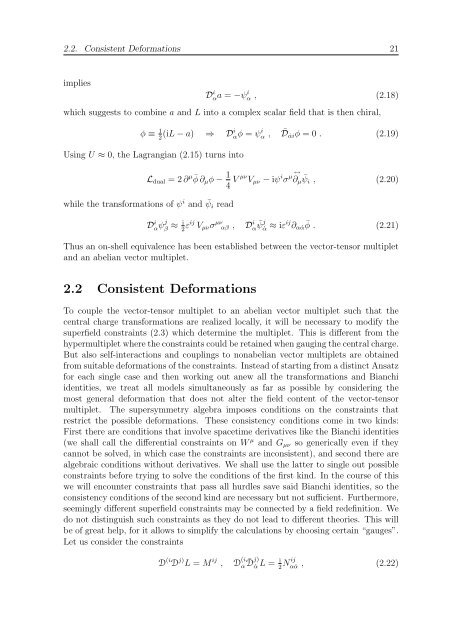N=2 Supersymmetric Gauge Theories with Nonpolynomial Interactions
N=2 Supersymmetric Gauge Theories with Nonpolynomial Interactions
N=2 Supersymmetric Gauge Theories with Nonpolynomial Interactions
Create successful ePaper yourself
Turn your PDF publications into a flip-book with our unique Google optimized e-Paper software.
2.2. Consistent Deformations 21<br />
implies<br />
D i αa = −ψ i α , (2.18)<br />
which suggests to combine a and L into a complex scalar field that is then chiral,<br />
φ ≡ 1<br />
2 (iL − a) ⇒ Di αφ = ψ i α , ¯ D ˙αiφ = 0 . (2.19)<br />
Using U ≈ 0, the Lagrangian (2.15) turns into<br />
Ldual = 2 ∂ µ φ¯ ∂µφ − 1<br />
4 V µν Vµν − iψ i ↔<br />
µ<br />
σ ∂µ ¯ ψi , (2.20)<br />
while the transformations of ψ i and ¯ ψi read<br />
D i αψ j i<br />
β ≈ 2εij Vµνσ µν αβ , D i α ¯ ψ j<br />
˙α ≈ iεij∂α ˙α ¯ φ . (2.21)<br />
Thus an on-shell equivalence has been established between the vector-tensor multiplet<br />
and an abelian vector multiplet.<br />
2.2 Consistent Deformations<br />
To couple the vector-tensor multiplet to an abelian vector multiplet such that the<br />
central charge transformations are realized locally, it will be necessary to modify the<br />
superfield constraints (2.3) which determine the multiplet. This is different from the<br />
hypermultiplet where the constraints could be retained when gauging the central charge.<br />
But also self-interactions and couplings to nonabelian vector multiplets are obtained<br />
from suitable deformations of the constraints. Instead of starting from a distinct Ansatz<br />
for each single case and then working out anew all the transformations and Bianchi<br />
identities, we treat all models simultaneously as far as possible by considering the<br />
most general deformation that does not alter the field content of the vector-tensor<br />
multiplet. The supersymmetry algebra imposes conditions on the constraints that<br />
restrict the possible deformations. These consistency conditions come in two kinds:<br />
First there are conditions that involve spacetime derivatives like the Bianchi identities<br />
(we shall call the differential constraints on W µ and Gµν so generically even if they<br />
cannot be solved, in which case the constraints are inconsistent), and second there are<br />
algebraic conditions <strong>with</strong>out derivatives. We shall use the latter to single out possible<br />
constraints before trying to solve the conditions of the first kind. In the course of this<br />
we will encounter constraints that pass all hurdles save said Bianchi identities, so the<br />
consistency conditions of the second kind are necessary but not sufficient. Furthermore,<br />
seemingly different superfield constraints may be connected by a field redefinition. We<br />
do not distinguish such constraints as they do not lead to different theories. This will<br />
be of great help, for it allows to simplify the calculations by choosing certain “gauges”.<br />
Let us consider the constraints<br />
D (i D j) L = M ij , D (i<br />
α ¯ D j) i L =<br />
˙α<br />
2<br />
ij<br />
Nα ˙α , (2.22)

















